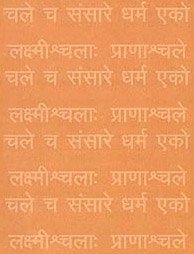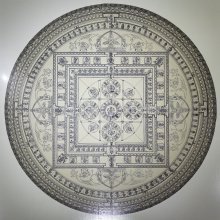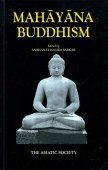Tathata, Tathatā, Tathātā: 14 definitions
Introduction:
Tathata means something in Buddhism, Pali, Hinduism, Sanskrit. If you want to know the exact meaning, history, etymology or English translation of this term then check out the descriptions on this page. Add your comment or reference to a book if you want to contribute to this summary article.
Images (photo gallery)
In Hinduism
Samkhya (school of philosophy)
Source: archive.org: Complete Works Of Swami Abhedananda (sankya)Tathata of the Buddhists corresponds to tanmatra of the Sankhya.—The Buddhists differ in many respects from the Sankhyan philosophers, but they agree also in many things, as advanced by the Sankhya.—Tanmatra of the Sankhya corresponds also to tathata of the Buddhists and their rupa-tathata has also been used for the Sankhyan rupa-tanmatra. Thus we find that the Buddhists incorporated some of the substance or matter as well as terminology of the Sankhya philosophy in the later days.

Samkhya (सांख्य, Sāṃkhya) is a dualistic school of Hindu philosophy (astika) and is closeley related to the Yoga school. Samkhya philosophy accepts three pramanas (‘proofs’) only as valid means of gaining knowledge. Another important concept is their theory of evolution, revolving around prakriti (matter) and purusha (consciousness).
In Buddhism
Theravada (major branch of Buddhism)
Source: Pali Kanon: Manual of Buddhist Terms and DoctrinesTathata (“suchness”) designates the firmly fixed nature (bhāva) of all things whatever.—The only passage in the Canon where the word occurs in this sense, is found in Kath. 186 (s. Guide, p. 83).—On the Mahāyana term tathatā, s. Suzuki, Awakening of Faith, p. 53f. (App.).
Theravāda is a major branch of Buddhism having the the Pali canon (tipitaka) as their canonical literature, which includes the vinaya-pitaka (monastic rules), the sutta-pitaka (Buddhist sermons) and the abhidhamma-pitaka (philosophy and psychology).
Mahayana (major branch of Buddhism)
Source: Wisdom Library: Maha Prajnaparamita Sastra1) Tathatā (तथता) refers to the “manner of being” and is mentioned as one of the synonyms of Dharmatā (the ‘dharma-nature’ or ‘true nature’ of dharmas), according to Mahāprajñāpāramitāśāstra chapter XLIX. Accordingly, “the Tathatā ‘manner of being’ of all dharmas is of two kinds: i) the specific nature (svalakṣaṇa) belonging to each dharma; ii) the dharmatā ‘true nature’. The specific nature belonging to each dharma is, for example, the solidity (khakkhaṭatva) of earth (pṛthivi), the wetness (dravatva) of water (ap-), the warmth of fire (uṣṇatva) of fire (tejas), the mobility (īraṇatva) of wind (vāyu): such natures differentiate dharmas, each of which has its own nature”.
While not seeing permanent dharmas, seeing impermanence (anityatā) is a wrong view (mithyādṛṣṭi). And it is the same for the views of suffering, emptiness, non-self and impurity. That is what is called tathatā. [...] Having acquired this tathatā of dharmas, one penetrates into the dharmadhātu, one eliminates all opinions (vipaśyanā) and does not conceive any further beliefs, for “such is its essence. [...] Finally, to completely penetrate (supravidh-) the dharmadhātu is bhūtakoṭi.
2) Tathatā represents the sameness of dharmas throughout the three times.—At the moment when dharmas are not yet arisen (ajāta) and at the moment of their arising dharmas are ‘thus’ (tathā). Once arisen, whether they are past (atīta) or present (pratyutpanna), they are are also ‘thus’ (tathā). This sameness of dharmas throughout the three times is called tathatā. In the true nature of dharmas (bhūtalakṣaṇa or dharmatā), the three times are identical and not different. As is said in the Prajñāpāramitā-sūtra in the Jou p’in chapter (Tathatāparivarta): “the past tathatā, the future tathatā, the present tathatā and the tathatā of the Tathāgata are one and the same tathatā and are no different”.
Source: academia.edu: A Study and Translation of the GaganagañjaparipṛcchāTathatā (तथता) refers to “suchness”, according to the Gaganagañjaparipṛcchā: the eighth chapter of the Mahāsaṃnipāta (a collection of Mahāyāna Buddhist Sūtras).—Accordingly, “The world (loka) is the five parts of the personality. Having known that the form (rūpa) is impermanent (anitya), [...] the Bodhisattva gives a gift, entering the suchness of giving through the suchness of form. Then he understands the suchness of transforming through the suchness of giving, the suchness of awakening through the suchness of transforming, the suchness of living being through the suchness of awakening, the suchness of the self through the suchness of living being, and the suchness of all dharmas through the suchness of the self. This the suchness of all dharmas is the absence of suchness, is not different from suchness (avitathatā), and nothing else but suchness (ananyathā). Since he gives a gift by understanding suchness (tathatā), son of good family, this giving is the supramundane path of Bodhisattvas”.

Mahayana (महायान, mahāyāna) is a major branch of Buddhism focusing on the path of a Bodhisattva (spiritual aspirants/ enlightened beings). Extant literature is vast and primarely composed in the Sanskrit language. There are many sūtras of which some of the earliest are the various Prajñāpāramitā sūtras.
Tibetan Buddhism (Vajrayana or tantric Buddhism)
Source: archive.org: The Indian Buddhist IconographyTathatā (तथता) or Tathatāvaśitā refers to one of twelve Vaśitā Goddesses, as commonly depicted in Buddhist Iconography, and mentioned in the 11th-century Niṣpannayogāvalī of Mahāpaṇḍita Abhayākara.—Her Colour is white; her Symbol is a bunch of jewels; she has two arms.—These Vaśitās are collectively taken to be the spiritual daughters of the Dhyāni Buddha Amitābha. The twelve Vaśitā Goddesses [viz., Tathatā-Vaśitā] are described collectively as two-armed, holding in their right hands the lotus and in the left proudly bearing their special symbols.
Source: OSU Press: Cakrasamvara SamadhiTathatā (तथता) or Tathatājñāna (“the wisdom of thusness”) refers to one of the “five wisdoms” (Pañcajñāna), according to the Saṃvaramaṇḍala of Abhayākaragupta’s Niṣpannayogāvalī, p. 45 and n. 145; (Cf. Cakrasaṃvaratantra, Gray, David B., 2007).—The crown of five skulls symbolize the pañcajñāna, "The Five Wisdoms": 1) ādarśa-jñāna, "mirror-like wisdom", 2) samatā-jñāna, "the wisdom of equality", 3) pratyavekṣā-jñāna, "discriminating wisdom", 4) kṛtyanuṣṭhāna-jñāna, "the wisdom of action", 5) tathatā-jñāna, "the wisdom of thusness".

Tibetan Buddhism includes schools such as Nyingma, Kadampa, Kagyu and Gelug. Their primary canon of literature is divided in two broad categories: The Kangyur, which consists of Buddha’s words, and the Tengyur, which includes commentaries from various sources. Esotericism and tantra techniques (vajrayāna) are collected indepently.
Buddhist philosophy
Source: Google Books: The Treasury of Knowledge: Book six, parts one and two (philosophy)Tathatā (तथता) refers to the “absolute reality” and represents one of the nine aspects of the “consummate nature” (pariniṣpanna), which represents one of the five parts of the “three natures” (trilakṣaṇa), according to Khewang Yeshe Gyatso, Exegetical Memorandum, chapter 7 (Cf. Śatasāhasrikāprajñāpāramitā).—The term “consummate nature” (pariniṣpanna) refers to the actual reality of all phenomena, the original ultimate [truth]. [...] The consummate nature also has nine further aspects [e.g., tathatā], as is stated in the Extensive Mother (Yum rgyas pa).
-
Languages of India and abroad
Pali-English dictionary
Source: BuddhaSasana: Concise Pali-English Dictionarytathatā : (f.) reality; such likeness.
Source: Sutta: The Pali Text Society's Pali-English DictionaryTathatā, (f.) (abstr. fr. tathā›tatha) state of being such, such-likeness, similarity, correspondence Vism. 518. (Page 296)

Pali is the language of the Tipiṭaka, which is the sacred canon of Theravāda Buddhism and contains much of the Buddha’s speech. Closeley related to Sanskrit, both languages are used interchangeably between religions.
Sanskrit dictionary
Source: DDSA: The practical Sanskrit-English dictionaryTathātā (तथाता).—
1) Such a state, being so.
2) True state or nature, truth.
3) The case being admitted to be as stated.
See also (synonyms): tathātva.
Source: Cologne Digital Sanskrit Dictionaries: Edgerton Buddhist Hybrid Sanskrit DictionaryTathatā (तथता).—f., and tathatva, nt., once tathatvatā (= Pali tathatā, tathatta; note that Pali has actually an adj. and subst. tatha = sacca, Sanskrit satya, true, truth; it has not been noted in [Buddhist Hybrid Sanskrit]; it was probably a Pali back- formation from these nouns, and/or from such [bahuvrīhi] cpds. as vi-tatha; [Buddhist Hybrid Sanskrit] also has the more Sktized tathātā, °tva, qq.v., but they are rare), true essence, actuality, truth: (the Saddharmapuṇḍarīka is) asaṃbhinna-tathatā Saddharmapuṇḍarīka 473.8 (prose), unmixed truth (Kern); tathatā bhavet katividhā Laṅkāvatāra-sūtra 25.17 (verse); tathatāparivarto nāma Aṣṭasāhasrikā-prajñāpāramitā 306.1 (title of chapter); anujātas tathatāṃ subhūtiḥ sthaviras tathāgatasya 307.1 (prose), the Elder S. is created after the manner of the truth (true nature) of the T.; and often in the sequel; tathatā tathateti…śūnyatāyā etad adhivacanaṃ Śikṣāsamuccaya 263.1 (prose), ‘truth, truth’—this is a designation for nullity; sāsau paramā (so probably read for ed. sā sauparamā) ta- [Page248-b+ 71] ṭhatā…Bodhisattvabhūmi 38.26 (prose), this is that supreme truth; tathatāyāṃ tathatvataḥ (…dharmavideśo) Lalitavistara 437.1 (verse; v.l. tathātvataḥ), in truth, according to reality; both stems together also in tathata-sama tathatvād (dhar- matā) Daśabhūmikasūtra.g. 26(52).2, alike in true nature according to truth; tathatvāya (i.319.6 °āye) dhārayiṣyanti Mahāvastu i.319.6; ii.257.15; iii.337.15 (prose), will hold it fast for truth, make certain that it is true; tathatvāya pratipadyate (Gaṇḍavyūha °yante) Daśabhūmikasūtra 19.13; Gaṇḍavyūha 181.14 (prose); ekā ca tasya (read tasyo; sc. dharmasya) samatā tathatvam Saddharmapuṇḍarīka 128.6 (verse), it has one sameness and true nature; tathatvatāyāṃ (!loc. sg.) pratipanno Kāśyapa Parivarta 125.4 (prose), resorted to the truth; tathatā- yāṃ, in truth, Aṣṭasāhasrikā-prajñāpāramitā 320.15; 321.2 (see pravibhāvayati).
--- OR ---
Tathātā (तथाता).—q.v.: Mahāvyutpatti 1709; 1716; 1721; Vajracchedikā 37.3. In Mahāvyutpatti 620 Kyoto ed. also tathātā-, but the true reading is Tathatā(-sthitaniścitta, q.v.).
Tathātā can also be spelled as Tathatā (तथता).
Source: Cologne Digital Sanskrit Dictionaries: Monier-Williams Sanskrit-English DictionaryTathātā (तथाता):—[=tathā-tā] [from ta-thā > tat] f. true state of things, true nature, [Vajracchedikā 17.]
[Sanskrit to German]
Sanskrit, also spelled संस्कृतम् (saṃskṛtam), is an ancient language of India commonly seen as the grandmother of the Indo-European language family (even English!). Closely allied with Prakrit and Pali, Sanskrit is more exhaustive in both grammar and terms and has the most extensive collection of literature in the world, greatly surpassing its sister-languages Greek and Latin.
See also (Relevant definitions)
Starts with: Tathatajnana, Tathataprabha, Tathatasthitanishchitta, Tathatasthitanishcitta, Tathatatha, Tathatavashita.
Ends with: Ananyatathata, Atmatathata, Avitathata, Bodhitathata, Danatathata, Dharmatathata, Kayatathata, Parinamanatathata, Prajnatathata, Rupatathata, Sarvadharmatathata, Satvatathata, Shilatathata, Skandhatathata, Smrityupasthanatathata, Vijnanatathata, Vitathata.
Full-text (+17): Tathatasthitanishcitta, Tathatva, Suchness, Tathatvata, Tanmatra, Bhutakoti, Sauparama, Avinashin, Adhivacana, Pancajnana, True Suchness, Sambhinna, Samata, Adarsha, Krityanushthana, Pratyaveksha, Svabhavanutpatti, Avitathata, Akshobhyavajra, Niyama.
Relevant text
Search found 17 books and stories containing Tathata, Tathatā, Tathātā, Tatha-ta, Tathā-tā; (plurals include: Tathatas, Tathatās, Tathātās, tas, tās). You can also click to the full overview containing English textual excerpts. Below are direct links for the most relevant articles:
Maha Prajnaparamita Sastra (by Gelongma Karma Migme Chödrön)
Part 2 - Understanding tathatā, dharmatā and anutpādakoṭi < [Chapter L - Arriving at the other Shore]
Note (2): The Mahāyānist dharmatā < [Part 2 - Understanding dharmatā and its synonyms]
IV. Supplementary explanations < [Part 2 - Understanding dharmatā and its synonyms]
Mahayana Buddhism and Early Advaita Vedanta (Study) (by Asokan N.)
Chapter 4.4 - Reality in Madhyamika (d): Rupa and Tathata
Chapter 4 - Reality according to Madhyamika and Advaita (introduction)
Chapter 4.3 - Reality in Madhyamika (c): The Paramita Discipline
The 6th Patriarch Platform Sutra
Buddha-nature (as Depicted in the Lankavatara-sutra) (by Nguyen Dac Sy)
1. Early period (d): The Ratnagotravibhāgaśāstra < [Chapter 2 - The Buddha-Nature in the Tathāgatagarbha Literature]
The Universality of the Buddha-nature < [Introduction]
4.1. Origin and Development of the Dharmakāya < [Chapter 4 - The Thought of Buddha-Nature in the Laṅkāvatārasūtra]
A History of Indian Philosophy Volume 1 (by Surendranath Dasgupta)
Part 11 - Mahāyānism < [Chapter V - Buddhist Philosophy]
Part 19 - Brief survey of the evolution of Buddhist Thought < [Chapter V - Buddhist Philosophy]
Part 13 - Uncompromising Idealism or the School of Vijñānavāda Buddhism < [Chapter V - Buddhist Philosophy]
Complete works of Swami Abhedananda (by Swami Prajnanananda)
Chapter 3 - Buddha and Kapila < [Discourse 7 - Thoughts on Sankhya Buddhism and Vedanta]
Preface < [Discourse 8 - The Steps towards Perfection]
Chapter 4 - Buddhist Councils And Buddhist Thoughts < [Discourse 7 - Thoughts on Sankhya Buddhism and Vedanta]
Related products



